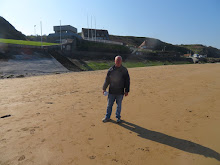My left ankle has been tender for awhile now. I woke up on Monday with it sore from my weekend training, which was a diminished workload anyway.
On Saturday I ran seven miles with my 10K Group Training Program at a ten-minutes-per-mile pace. That program’s 10K race is only three weeks away and since I was one of only two coaches who showed up, I took half the runners out.
On Sunday I practiced running at an 8:30-minutes-per-mile pace, the target pace I set for the upcoming marathon which I recently signed up for. I averaged 8:09 for the first five miles, not very close to an 8:30 pace you might say, but for those of us who still don’t have a Garmin, we have to just run by feel on the trail from one milepost to another, and see where we’re at on the watch when we arrive. I then ran the sixth mile in 7:38 to practice bearing down at the end.
Monday my ankle was suffering so I "just" ran a mile, at what I hoped was an easy 8-minute pace (7:51). Tuesday morning I lay in bed wiggling my ankle and I decided to take a day off from running, a decision I second-guessed all day long. I had put together a team for my agency for a 3-mile race coming up the next morning (today), the ACLI Capital Challenge, and my ankle was not feeling good all day long yesterday.

This morning though, my ankle felt much better after a full day of rest. Imagine that! (Right: A, M and G at the 2006 ACLI Capital Challenge 3-Mile Race in Anacostia Park in SE. The race t-shirts were yellow that year. After running a 21:22, M didn't run the next year.)
I slipped on my heavy ankle brace and went off to the 8 am race, feeling that perhaps I wouldn’t let the team down this year. It was a beautiful morning to
 run, cool, breezy and sunny, with no humidity. (Left: My agency's 2007 team. The race t-shirts were green last year. After running a 21:09, A departed the agency.)
run, cool, breezy and sunny, with no humidity. (Left: My agency's 2007 team. The race t-shirts were green last year. After running a 21:09, A departed the agency.)I was third on my team of five, finishing over three minutes behind my agency’s rock star, G, and two minutes behind M, who always beats me but who has been absolutely killing me lately at the monthly noontime Tidal Basin 3K race. However, I achieved my personal gold standard because I hit every one of my pre-race goals. I PR’ed, broke 22 minutes for the distance, got my 3-mile PR faster than my 5K PR and beat my doppelganger Peter, who had beaten me the prior two years. I’ll give you a race report after the official results go up.






















